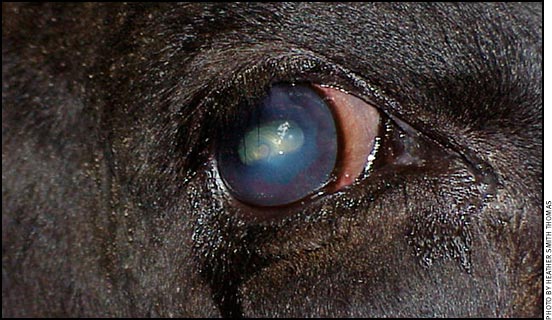
Pinkeye Is A Common Summer Problem
Veterinarian Austin Hinds, University of Idaho Caine Center, says pinkeye is associated with Moraxella bovis bacterium and is very contagious.
“It can be transmitted by nose-to-nose contact, fluid from the eye or rubbing the face on another animal,” he explains. “Face flies carry it from animal to animal and irritate the eyes, making them more vulnerable.”
Microscopic “teeth” on the end of the face fly’s tongue make the eye water. The protein-rich eye secretions are the mainstay of a face fly's diet. Pinkeye bacteria gain access to the eye via tiny wounds in the cornea caused by the fly.
“The bacteria by themselves may not cause the disease. There must be irritation. This is why pinkeye is more common when flies are present, when grass is tall (brushing the eyeball), conditions are dusty or there is more sunlight. UV (ultraviolet) radiation by itself can cause enough corneal inflammation to predispose the eye to pinkeye,” explains Hinds.
Antibiotics can resolve it quickly in early stages.
“Over-the-counter injectable antibiotics labeled for pinkeye are just as effective as more expensive prescription antibiotics. Any of these will work, especially in early stages where the eye is simply irritated, watering and squinting — without much damage to the eyeball itself,” he says. “The injectable antibiotics reach high levels in the tears when given systemically (into the muscle or under the skin). Tears bathe the eyeball with antibiotics.”
This is much more effective than topical medications (squirted into the eye) that are quickly washed out by tears. An eye affected by pinkeye produces more tears (because of the pain and irritation) than a normal, healthy eye.
Often a veterinarian will inject medication into the inner surface of the eyelid, says Hinds. “Penicillin is commonly used, often mixed with a steroid to help reduce pain and inflammation.”
Injecting medication under the epithelium of the inner surface of the eyelid acts as a slow-release treatment.
“It keeps leaking out, bathing the eyeball with antibiotic,” Hinds says. “Treating the animal systemically with antibiotics is easiest, however. Studies show it doesn’t matter which method you use, as long as you treat the animal before serious damage occurs. If the eyeball ruptures, it can’t be saved, but eyes with deep ulcerations can heal, especially if you protect the eye.”
Some veterinarians suture the eyelids together to keep the eye closed, and some pull the third eyelid across the eyeball and suture it there. Either method can be done on the farm, with the cow restrained in a chute, and will protect the eyeball from trauma, sunlight, dust, etc. Being covered helps the eye heal faster, keeping it from drying out and constantly bathed by its own tears.
“Eye patches are not as good as suturing the lids,” says Hinds. “Patches don’t keep the eye closed and come off too easily.” If the eye is damaged and blind, protect it while it heals. Keeping the lids closed or the third eyelid over the eyeball speeds recovery.






